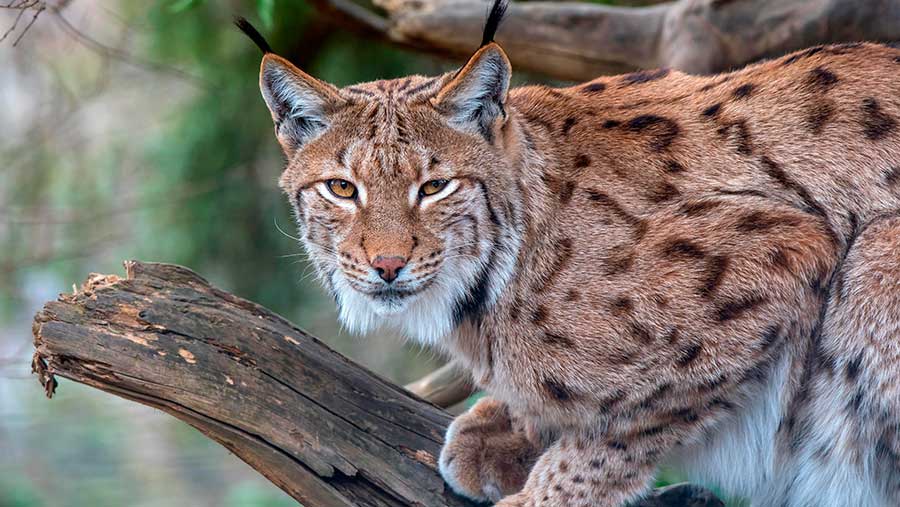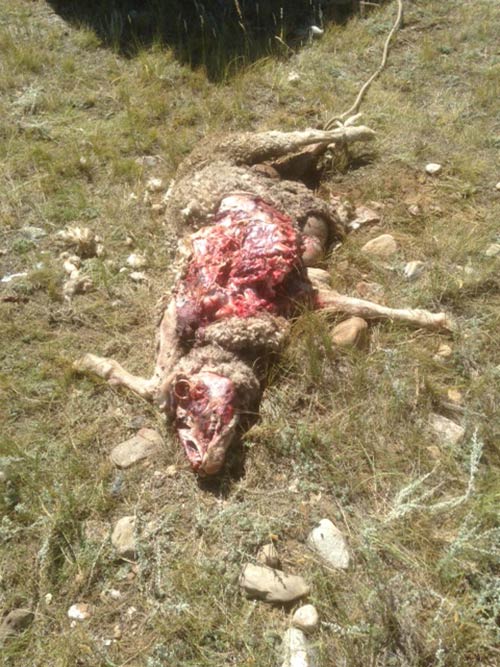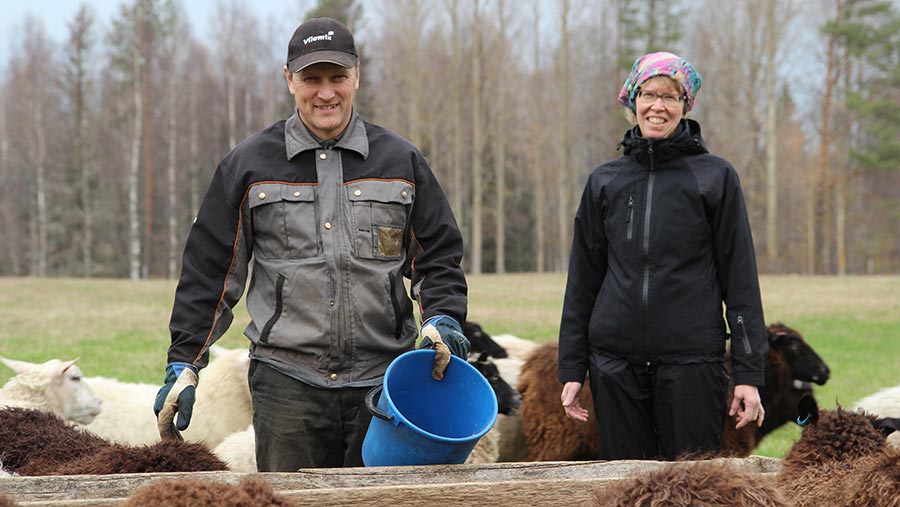How livestock producers cope with predators
 A Eurasian lynx © Reinhard Holzl/imageBROKER/REX/Shutterstock
A Eurasian lynx © Reinhard Holzl/imageBROKER/REX/Shutterstock Introducing large carnivores into the British countryside is a notion that has left many livestock farmers concerned about increased sheep mortality and unwanted extra costs.
Through reintroducing species such as beavers, wolves and lynx, wildlife experts believe ecosystems can function more naturally with less human management.
The National Sheep Assocation and many farmers have vehemently criticised the controversial plan amid concerns it would increase sheep mortality and the application is still being considered by Natural England and Defra.
See also: Finnish farmer delivers stark warning on lynx
Farmers Weekly spoke with livestock producers abroad to find out what sort of threat predators pose to livestock and how they control them.
Dave and Lenora McEwan, Whitlash, Montana

The McEwen family on the farm in Montana
A wide range of predators take a bite out of ranch profits for the McEwens, who sell store lambs and weaned calves every October from their northern Montana beef and sheep operation.
Coyotes, a smaller relative of the wolf, are the main predators, although new challenges include increasing numbers of turkey vultures and ravens.
Farm facts
- 800 Rambouillet and Targhee (Ramouillet cross Corriedale cross Lincoln) ewes
- 250 commercial Angus suckler cows
- 2,471ha of rangeland pasture
- Rotationally grazing four 600-800ha pastures
Both birds can peck the eyes out of live calves and lambs, resulting in death. Mr McEwen has seen a vulture peck out the eyes of a live calf during birth.
Just six miles from the Canadian border, the McEwen’s also have to contend with grizzly bears, foxes and eagles.
Implications
The McEwens have lambed indoors for more than 10 years and use guard dogs to protect their sheep, but lambing losses can still be high.
Over the past 10 years predators have taken between 35 and 150 lambs a year, averaging out at 10-15% of the sheep operation’s annual profit.
On top of this there are occasional calves that die or are attacked, with predators forming part of a 1-1.5% herd calf mortality figure by the end of calving.

A sheep killed by a grizzly bear
Compensation is available only for animals confirmed by the government to have been killed by bears, wolves or mountain lions (also known as cougars or pumas) in the state of Montana – but not coyotes. Full market value is paid for the animal at its intended point of sale.
“Depending on where you’re ranching, and what the predator is, it could be 3:1 or 10:1 in terms of non-confirmed to confirmed kills,” says Mr McEwen.
Reducing predation
Eight guard dogs of varying breeds (including Spanish mastiff and Turkish akbash) protect the flock all year.
Feeding the dogs costs £1.55/day, with veterinary and medicine costs on top. The dogs cost from about £230 up to more than £1,000.
Management options
- Shooting: Adult coyote pairs are controlled, both by the USDA Wildlife Service from helicopters and by the McEwens themselves.
- Fencing: Net wire fencing extends across pasture perimeters.
- Guard dogs: Eight large guard dogs are used on the ranch.
- Chemical traps: Coyotes and foxes are controlled with M44s (also known as cyanide traps). These mechanical devices are smeared in scented bait and shoot sodium cyanide crystals when activated by being bitten and pulled. The chemical reacts with the animal’s saliva and creates cyanide gas, killing it in seconds. They are said to be very species-specific.
- Housed lambing in May (both because of snow and predators) lifted lambing percentages from 80% to 135% at the end of lambing.
Hannu and Pirjo Iso-Junno, Kivikangas Farm, Northern Ostrobothnia, Finland

Hannu and Pirjo Iso-Junno
Organic sheep farmers Hannu Iso-Junno and his wife Pirjo are using electric fencing to protect their flock from Finland’s growing wolf population.
Legislation protects wolves in Europe, meaning they can only be shot by people with special dispensation.
Farm facts
- 160 pedigree Finnsheep ewes farmed organically
- Lambing indoors producing almost 400 lambs a year
- 61ha of mostly pasture and silage ground
- Growing peas and barley for forage
However, the Finnish government pays for farms to erect electric fencing in certain wolf “hot spots”, including where the Iso-Junnos farm. The fences, which the farmers erect themselves, are 1.4m high and have five or seven wires.
Data from Natural Resources Institute Finland (LUKE) shows that wolf numbers are increasing in western Finland.
Implications
Wolves have been attacking the sheep at Kivikangas for the past three years, with 20 ewes lost in two attacks in 2017.
The cost to the farm has been in the thousands of euros, with pedigree Finnsheep bought into flocks for £260-£350 and the total cost of extra work and expenses amounting to £440 per dead ewe.
The Finnish government compensates farmers for the market value of dead livestock, providing farmers find all corpses and can prove they were killed by predators (including wolves, bears, lynx and wolverines).
As a protective measure, the flock is now housed two months early, meaning extra silage, extra labour and extra bedding.
Challenges
Even with electric fencing and indoor lambing, the Iso-Junnos still lose sheep, even from pastures adjacent to the house.
Guard dogs are one option, but Mr Iso-Junno says this is hardly practical as they would require 10 dogs, with the flock bordering forest and woodland habitat.
Housing sheep at night is not always possible, with some pastures up to 10 miles away from the farm. Similarly, shouting and gunfire can be used to scare wolves away but this is time consuming and ineffective as the wolves return within hours or sometimes minutes.
Keli Hendricks and Dean Spinelli, Sonoma County, California

Dean Spinelli and Keli Hendricks
An animal science graduate, rancher and wildlife management consultant, Keli Hendricks has worked on ranches her whole life and has learnt the folly of killing coyotes to control their numbers.
Through working alongside her husband Dean and consulting with Project Coyote – a US-wide non-profit education and conservation organisation – Keli has seen that coyotes can co-exist with cattle.
“Shooting coyotes disrupts their hierarchical structure and often makes them breed more,” says Mrs Hendricks. “If populations are stable, only adult pairs breed and have small litters. However, if you kill adults then more pack members breed and have larger litters in response, so a ranch can end up with more coyotes.”
Ranch facts
- 200 cross-bred cattle including Angus, Hereford, Brahman and Charolais genetics
- Commercial operation covering more than 1,600ha
- Advocating non-lethal predator control methods
- Grazing alongside bobcats (a species of lynx), coyotes, eagles and mountain lions
- 0.5% predator losses on average per year
Management options
There is no silver-bullet solution, but by suggesting a range of options for ranches to try, Mrs Hendricks and her colleagues at Project Coyote have shown it is possible to manage predators without killing them.
Non-lethal methods that have been trialled
- Hazing with guns: Shooting above the coyote’s head to let it know it is being watched. Shooting to frighten rather than kill.
- Guardian dogs: Guardian dogs are used in extensive ranching countries including the US and Australia. Dogs vary from being able to kill predators to simply protecting sheep and calves and deterring predators from coming close.
- Scare tape: Putting novel objects around lambing and calving areas such as reflective tape on fencing can scare predators away temporarily – this may only work for short periods but can be useful if the ranch is a guard dog down or during key times such as calving.
- Lights and sound: Ultrasound collars are expensive (£70/collar) but are being used to dissuade predators from coming near livestock at night. Similarly, flashing lights on fence posts can be used temporarily to make it appear that humans are protecting the flock.
- Tactical calving: First-calving heifers can be brought into better-fenced areas closer to home to calve. They have not yet learnt to leave their calves in nursery areas with babysitters cows before they go off to graze.
- Regular lookouts: Daily human presence can deter predators from areas at key times of the year. While extra efforts are being made to watch over lambs or sheep, larger adult animals can possibly be checked on less often.
